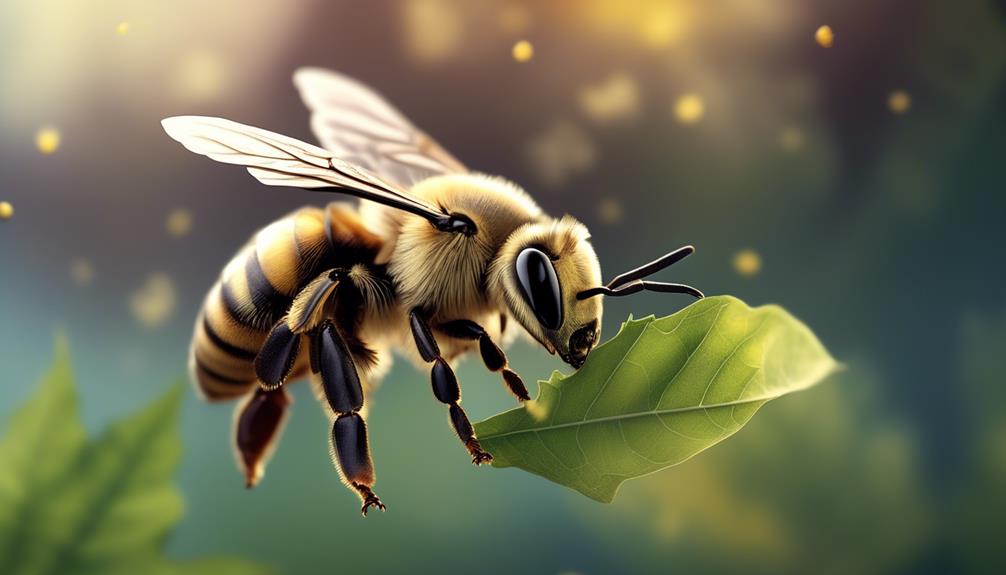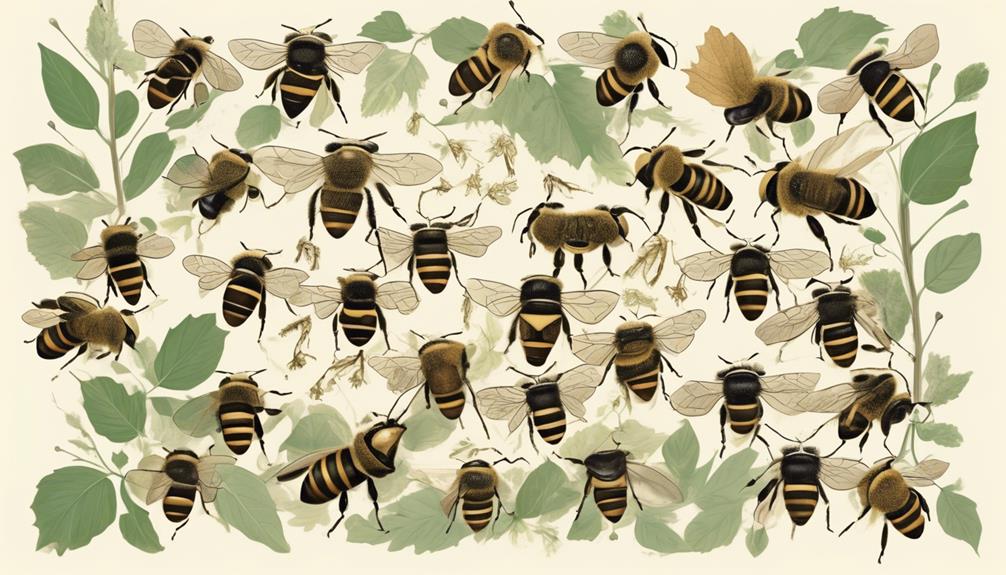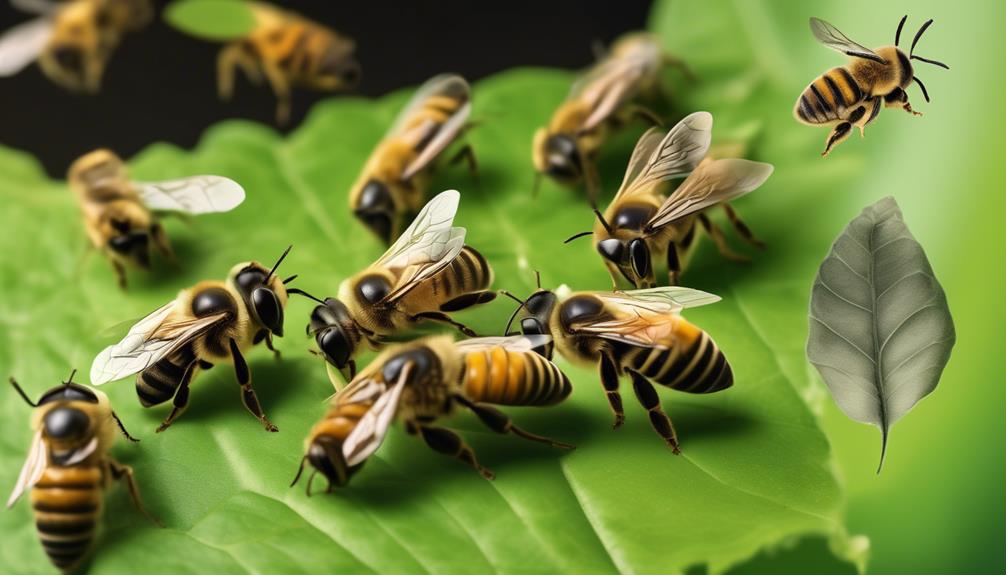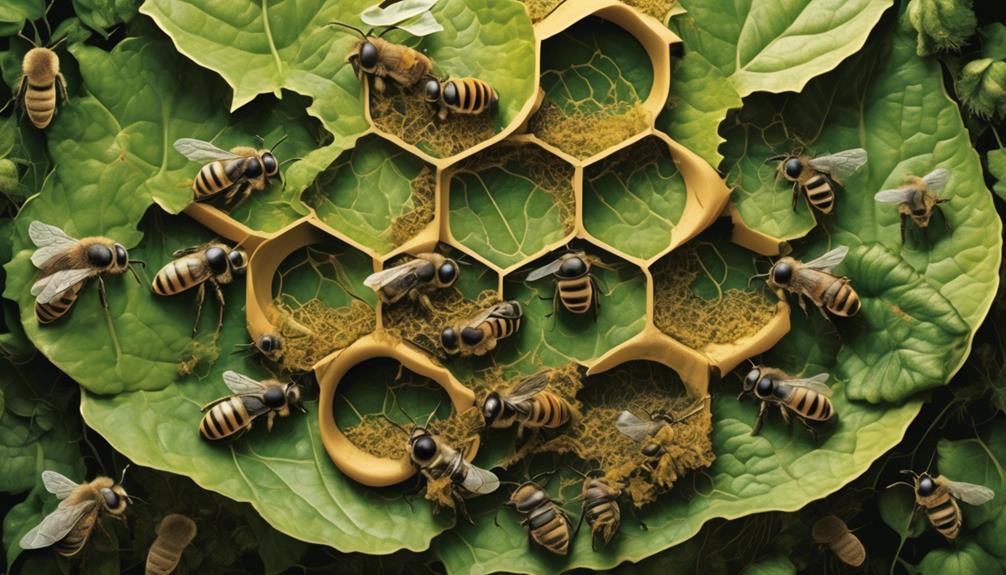An exploration into the social habits of leafcutter bees, revealing unexpected truths about whether these solitary creatures swarm.

Do Leafcutter Bees Swarm?
Imagine a world where towering skyscrapers of bees swarm in the skies, blotting out the sun. Well, you can breathe a sigh of relief because we're not discussing those kind of bees. We're diving into the fascinating world of leafcutter bees, a species you might not be familiar with.
Unlike honeybees or bumblebees, leafcutter bees are solitary creatures. But does that mean they never swarm? We're about to explore the intriguing social structure and behaviors of these buzzing insects, shedding light on whether or not they swarm.
And trust me, the answer might surprise you.
Key Takeaways
- Leafcutter bees are solitary creatures and do not engage in swarming behavior.
- Each female leafcutter bee constructs her own nest and provisions it for her offspring.
- Leafcutter bees are efficient pollinators and contribute to biodiversity.
- Their non-aggressive nature and low pest potential make them less of a nuisance compared to other bee species.
Understanding Leafcutter Bees

To fully understand leafcutter bees, you need to delve into their unique biology, intricate life cycle, and fascinating behaviors. Unlike honeybees, they're solitary creatures, meaning each female crafts her own nest. They're also known as Megachilidae, a family that's diverse and widespread. You'll find them in every continent except Antarctica.
You'll notice leafcutter bees busily cutting neat circular pieces from leaves. They're not being destructive; they're gathering materials to build their unique homes. These circles of leaves serve as individual cells in their nest where they lay eggs. Within these cells, they deposit a mix of nectar and pollen, which provides nutrition for the larvae.
Their life cycle is a marvel. From the egg, they metamorphose into larvae, pupae, then finally into adults. Adult females die after laying their eggs, leaving the new generation to continue the cycle. You'll also find that they're not aggressive. They'll sting if threatened, but it's often less painful than a honeybee's.
Understanding these bees is vital, as they're essential to our ecosystem. They're efficient pollinators, often more so than honeybees. They're also an integral part of the food chain, serving as prey for various predators.
Leafcutter Bees' Social Structure

Despite their solitary nature, leafcutter bees exhibit a complex social structure that you'll find intriguing. Unlike honeybees that live in large colonies, leafcutters are solitary bees. However, don't mistake 'solitary' for 'antisocial'. These bees often nest in close proximity to each other, forming loose aggregations.
The female is the dominant figure in leafcutter society. She's responsible for finding a suitable nesting site, and it's her job to prepare the nest for her offspring. She does this by cutting leaf fragments, which she transports back to her nest, using them to construct a series of brood cells. Each cell is then provisioned with a mixture of nectar and pollen, followed by laying a single egg.
Once her nest is full, the female seals it off, leaving her offspring to develop on their own. There's no ongoing maternal care in this bee society. The offspring are left alone to metamorphose into adults, who then leave the nest to start the cycle over again.
This social structure allows leafcutter bees to be highly efficient pollinators. Their solitary yet social behavior enables them to adapt to a variety of environments, showcasing an impressive degree of evolutionary sophistication.
Swarming Behavior in Bees

While observing the solitary yet social behavior of leafcutter bees, you might wonder how swarming, a distinct behavior often associated with bees, factors into their way of life. Contrary to what you might expect, leafcutter bees don't typically engage in swarming. They're solitary bees, meaning they don't live in large groups or colonies like honeybees or bumblebees.
Swarming, you see, is a reproductive strategy observed primarily in social bees. It occurs when a queen, accompanied by a large group of worker bees, leaves the colony to establish a new one. This behavior is integral to the survival and proliferation of social bee species.
However, leafcutter bees have a different approach. Each female is fertile and constructs her own nest, often in close proximity to others, hence the semblance of a social structure. You won't see them swarming because they don't have a queen to follow or a colony to abandon. Instead, they lay eggs individually, each bee providing for her own offspring.
Understanding this distinction helps you appreciate the unique behavior and lifestyle of leafcutter bees.
Do Leafcutter Bees Swarm?

You might be wondering if leafcutter bees swarm, but the simple answer is no, they don't engage in this behavior. Unlike honey bees, which are social insects known for their swarming habits, leafcutter bees are solitary. Each female leafcutter bee builds her own nest, which she provisions with a mixture of pollen and nectar for her offspring.
What's fascinating about these bees is their method of constructing nests. They cut circular and oval pieces of leaves, hence their moniker, and use them to build brood cells in their nests. The nests are typically found in rotting wood or in the stems of plants.
Furthermore, leafcutter bees aren't aggressive and rarely sting. Their solitary nature and non-aggressive behavior significantly reduce the chances of swarming.
Implications of Leafcutter Bees' Behavior

Understanding the implications of leafcutter bees' solitary and non-aggressive behavior can help enhance our strategies in pollination and pest management. As efficient pollinators, they can boost crop yields and contribute to biodiversity. Their non-aggressive nature also makes them less of a nuisance compared to other bee species that swarm and can be dangerous.
Here's a detailed comparison to illustrate this:
Leafcutter Bees | Honey Bees | Bumble Bees | |
|---|---|---|---|
Pollination | High | Medium | Low |
Aggression | Low | High | Medium |
Population | Solitary | Swarm | Colony |
Pest Potential | Low | High | Medium |
Despite their benefits, you must remember that leafcutter bees can cause some damage to foliage as they cut leaves to build their nests. However, this isn't typically detrimental to plant health. So, in your pollination and pest management strategies, it's crucial to balance these aspects. Consider the leafcutter bees' role in the ecosystem and the minor inconvenience they may pose. With careful planning, these bees can be a great asset in sustainable agriculture.
Conclusion
In sum, you've learned that leafcutter bees aren't the swarming type. Their solitary nature, contrasting with the swarm behavior of honey bees, is rooted in their unique social structure.
This individualistic behavior has profound implications for their role in ecosystems and their interactions with humans.
Always remember, not all bees are created equal – understanding their distinct behaviors can help us coexist harmoniously with these fascinating creatures.



